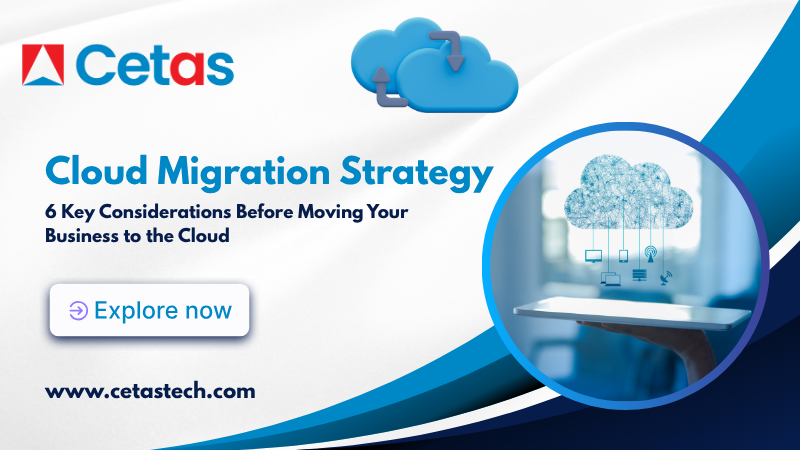Cloud Migration Strategy: 6 Key Considerations Before Moving Your Business to the Cloud
As digital transformation becomes a top priority for modern enterprises, cloud migration is no longer optional—it’s essential. For business owners and IT leaders exploring cloud-based ERP or digital infrastructure, the shift to the cloud promises flexibility, scalability, and cost-efficiency. But to unlock those benefits, you must approach your cloud migration journey with careful planning and clear goals.
At Cetas, we help organizations successfully migrate their legacy systems to cloud environments like Dynamics 365. Based on years of experience, here are six critical factors every business should evaluate before undertaking a cloud migration.
Why Cloud Migration Is a Strategic Business Move?
Before we dive into the checklist, let’s understand why cloud migration is gaining momentum across industries. Migrating your data, applications, and systems to the cloud:
- Reduces upfront infrastructure costs by eliminating the need for physical servers.
- Enables remote collaboration with secure, anytime-anywhere access.
- Improves scalability—you can add resources as your business grows without significant IT investments.
- Strengthens disaster recovery and data backup capabilities.
- Accelerates innovation by giving access to advanced tools like AI, analytics, and automation.
Whether you’re a small business seeking a competitive edge or a mid-sized enterprise planning digital modernization, a successful cloud migration strategy can be a game-changer.
1. Choose the Right Cloud Environment
One of the first decisions to make is selecting the type of cloud deployment model that aligns with your business needs:
- Public Cloud: Ideal for SMEs with limited IT resources. It offers pay-as-you-go pricing and is fully managed by third-party providers.
- Private Cloud: Suitable for businesses with high security or compliance requirements. It gives full control but requires in-house server maintenance.
- Hybrid Cloud: Combines both public and private models, allowing sensitive data to stay on-premises while leveraging cloud resources for scalability.
At Cetas, we help businesses determine which model best fits their industry, regulatory needs, and growth goals.
2. Understand the Total Cost and ROI of Cloud Migration
Cost is often the driving force behind moving to the cloud—but it’s essential to look beyond the headline savings. Factors impacting cloud migration costs include:
- Data transfer and storage
- Application refactoring or rehosting
- Third-party tools and licenses
- Training and change management
- Ongoing support and managed services
Although cloud reduces capital expenditure (CapEx), there will be operational expenses (OpEx) for usage, monitoring, and updates. The real ROI comes from increased agility, faster time-to-market, and reduced downtime.
3. Align Cloud Migration with Your Business Objectives
Your cloud migration strategy should not be just an IT initiative—it should serve your broader business goals. Common cloud migration drivers include:
- Faster deployment of ERP or CRM systems
- Improved data accessibility for remote teams
- Enhanced customer experience through automation
- Regulatory compliance and audit readiness
- Business continuity and disaster recovery planning
Before you migrate, conduct a cloud readiness assessment and a risk-benefit analysis to understand potential disruptions, performance impacts, and timeline constraints. Align your cloud roadmap with department-level goals to gain stakeholder buy-in and measurable outcomes.
4. Prioritize Cloud Security and Data Protection
Security is often cited as a major concern in cloud adoption—and rightfully so. While major cloud providers like Microsoft Azure offer robust, enterprise-grade security frameworks, you still need to ask:
- Where will your data be stored?
- What encryption standards are used?
- What access controls and identity management policies are in place?
- How is data backed up and restored in case of breach or loss?
At Cetas, we help businesses build secure cloud migration plans by integrating security at every layer—network, application, and user identity.
5. Ensure Regulatory Compliance During Migration
When migrating to the cloud, maintaining regulatory compliance is crucial to avoid legal risks and ensure long-term data integrity. Here’s what to consider:
- Evaluate compliance requirements based on your industry and operational geography. Understand how regulations may impact your cloud strategy.
- Classify data before migration to determine what can be moved to the cloud and what must remain on-premises.
- Check data residency obligations to ensure that sensitive or critical data is stored in approved geographic locations.
- Verify vendor certifications (such as ISO or SOC standards) to ensure your cloud provider meets global compliance frameworks.
- Ensure auditability and reporting by implementing tools that track access, changes, and activity within your cloud environment.
- Document governance policies that define how data security, privacy, and compliance will be managed after migration.
A reliable cloud provider should offer a compliance-ready infrastructure that aligns with your internal governance policies. At Cetas, we help you build a compliant, secure, and industry-ready cloud migration plan.
6. Plan for Backup, Recovery, and Business Continuity
Cloud downtime, although rare, can still happen. Before migration, develop a robust disaster recovery (DR) and business continuity strategy. Consider:
- Recovery Time Objectives (RTO) and Recovery Point Objectives (RPO)
- Redundant backups across geographic locations
- SLA agreements with uptime guarantees
- Real-time monitoring and alerts
Include these elements in your Service Level Agreement (SLA) with your cloud provider to avoid confusion during an actual incident.
Final Thoughts: Is Your Business Ready for the Cloud?
Migrating to the cloud is not just a technical shift—it’s a strategic business transformation. A well-planned migration reduces risk, minimizes disruption, and maximizes ROI.
By considering the six factors outlined above—cloud environment, cost and ROI, business goals, security, compliance, and recovery—you’ll be better prepared to make a smooth transition. If you’re exploring cloud migration for Microsoft Dynamics ERP, CRM, or analytics workloads, partner with experts who understand the end-to-end journey.
Ready to Migrate to the Cloud?
At Cetas, we’ve helped businesses across industries modernize their IT systems with secure, scalable, and compliant cloud migration services.
Contact us at sales@newsite.cetastech.com to get started with a tailored cloud readiness assessment and migration roadmap.

